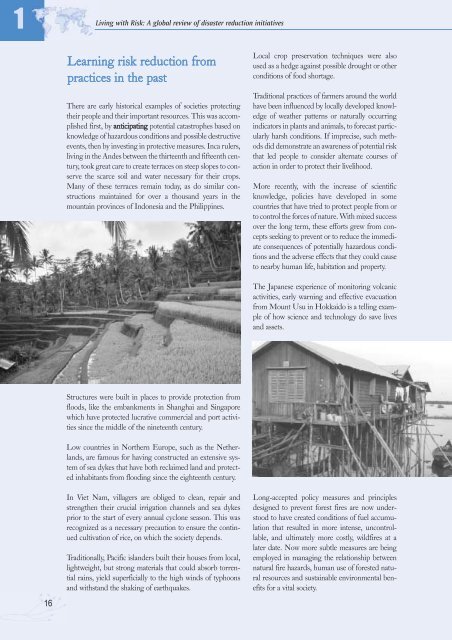A global review of disaster reduction initiatives - Welcome to the ...
A global review of disaster reduction initiatives - Welcome to the ...
A global review of disaster reduction initiatives - Welcome to the ...
Create successful ePaper yourself
Turn your PDF publications into a flip-book with our unique Google optimized e-Paper software.
1Living with Risk: A <strong>global</strong> <strong>review</strong> <strong>of</strong> <strong>disaster</strong> <strong>reduction</strong> <strong>initiatives</strong>Learning risk <strong>reduction</strong> frompractices in <strong>the</strong> pastThere are early his<strong>to</strong>rical examples <strong>of</strong> societies protecting<strong>the</strong>ir people and <strong>the</strong>ir important resources. This was accomplishedfirst, by anticipating potential catastrophes based onknowledge <strong>of</strong> hazardous conditions and possible destructiveevents, <strong>the</strong>n by investing in protective measures. Inca rulers,living in <strong>the</strong> Andes between <strong>the</strong> thirteenth and fifteenth century,<strong>to</strong>ok great care <strong>to</strong> create terraces on steep slopes <strong>to</strong> conserve<strong>the</strong> scarce soil and water necessary for <strong>the</strong>ir crops.Many <strong>of</strong> <strong>the</strong>se terraces remain <strong>to</strong>day, as do similar constructionsmaintained for over a thousand years in <strong>the</strong>mountain provinces <strong>of</strong> Indonesia and <strong>the</strong> Philippines.Local crop preservation techniques were alsoused as a hedge against possible drought or o<strong>the</strong>rconditions <strong>of</strong> food shortage.Traditional practices <strong>of</strong> farmers around <strong>the</strong> worldhave been influenced by locally developed knowledge<strong>of</strong> wea<strong>the</strong>r patterns or naturally occurringindica<strong>to</strong>rs in plants and animals, <strong>to</strong> forecast particularlyharsh conditions. If imprecise, such methodsdid demonstrate an awareness <strong>of</strong> potential riskthat led people <strong>to</strong> consider alternate courses <strong>of</strong>action in order <strong>to</strong> protect <strong>the</strong>ir livelihood.More recently, with <strong>the</strong> increase <strong>of</strong> scientificknowledge, policies have developed in somecountries that have tried <strong>to</strong> protect people from or<strong>to</strong> control <strong>the</strong> forces <strong>of</strong> nature. With mixed successover <strong>the</strong> long term, <strong>the</strong>se efforts grew from conceptsseeking <strong>to</strong> prevent or <strong>to</strong> reduce <strong>the</strong> immediateconsequences <strong>of</strong> potentially hazardous conditionsand <strong>the</strong> adverse effects that <strong>the</strong>y could cause<strong>to</strong> nearby human life, habitation and property.The Japanese experience <strong>of</strong> moni<strong>to</strong>ring volcanicactivities, early warning and effective evacuationfrom Mount Usu in Hokkaido is a telling example<strong>of</strong> how science and technology do save livesand assets.16Structures were built in places <strong>to</strong> provide protection fromfloods, like <strong>the</strong> embankments in Shanghai and Singaporewhich have protected lucrative commercial and port activitiessince <strong>the</strong> middle <strong>of</strong> <strong>the</strong> nineteenth century.Low countries in Nor<strong>the</strong>rn Europe, such as <strong>the</strong> Ne<strong>the</strong>rlands,are famous for having constructed an extensive system<strong>of</strong> sea dykes that have both reclaimed land and protectedinhabitants from flooding since <strong>the</strong> eighteenth century.In Viet Nam, villagers are obliged <strong>to</strong> clean, repair andstreng<strong>the</strong>n <strong>the</strong>ir crucial irrigation channels and sea dykesprior <strong>to</strong> <strong>the</strong> start <strong>of</strong> every annual cyclone season. This wasrecognized as a necessary precaution <strong>to</strong> ensure <strong>the</strong> continuedcultivation <strong>of</strong> rice, on which <strong>the</strong> society depends.Traditionally, Pacific islanders built <strong>the</strong>ir houses from local,lightweight, but strong materials that could absorb <strong>to</strong>rrentialrains, yield superficially <strong>to</strong> <strong>the</strong> high winds <strong>of</strong> typhoonsand withstand <strong>the</strong> shaking <strong>of</strong> earthquakes.Long-accepted policy measures and principlesdesigned <strong>to</strong> prevent forest fires are now unders<strong>to</strong>od<strong>to</strong> have created conditions <strong>of</strong> fuel accumulationthat resulted in more intense, uncontrollable,and ultimately more costly, wildfires at alater date. Now more subtle measures are beingemployed in managing <strong>the</strong> relationship betweennatural fire hazards, human use <strong>of</strong> forested naturalresources and sustainable environmental benefitsfor a vital society.

















